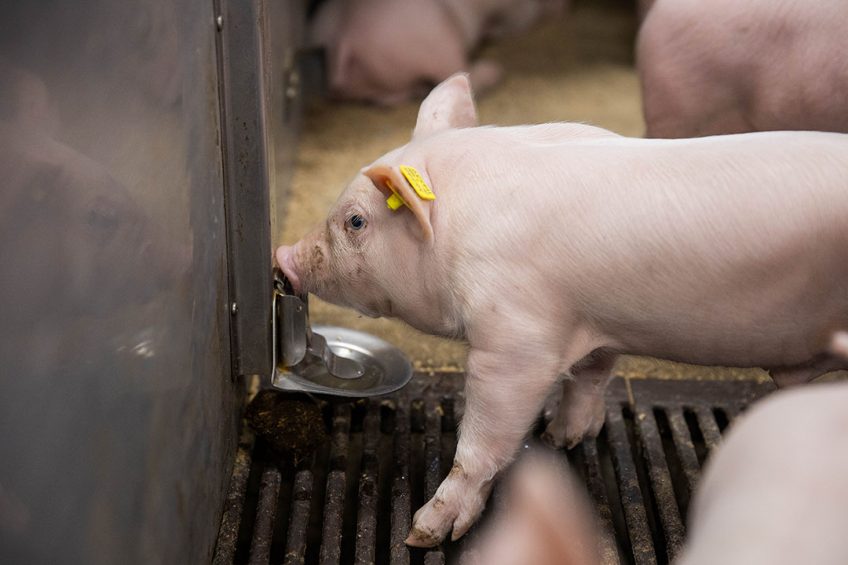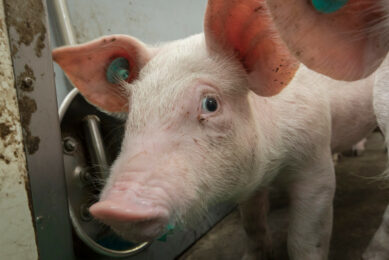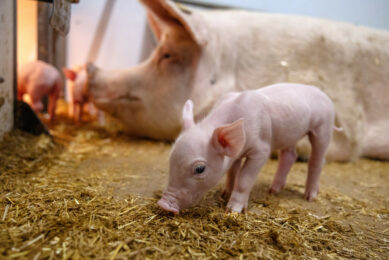Does a lower stomach pH improve performance?

What physiological factors within the piglet’s immature gastrointestinal tract contribute to weaning challenges and how can they be managed? A meta-analysis shows that water supplementation with organic acids can set a piglet up for improved growth performance by optimising stomach pH levels.
Regardless of a piglet’s vitality at farrowing, all piglets undergo gastrointestinal challenges during the post-weaning phase. The switch from sow milk to a commercial piglet diet stresses a piglet’s limited digestive capacity, resulting in undigested proteins reaching the hind gut – an ideal situation for various pathogens to proliferate. Consequently, piglets’ nutrient utilisation immediately after weaning is low, and performance drops.
How do pH levels support digestion?
The enzymes in the stomach that digest protein – such as pepsin – require a low pH level to activate. In suckling piglets, high levels of lactate in sow’s milk inhibit hydrochloric acid (HCI) secretion, but lactate keeps the stomach at low pH levels to support efficient digestion of milk’s nutrients. However, at weaning, several factors, including new feed, can contribute to an increased stomach pH – often at levels above pH 5.0.


The optimal stomach pH level for converting pepsinogen into pepsin (an enzyme that digests protein) is around 2.0–3.5 (Figure 1). During the first 3 to 4 weeks of life, the HCl production of piglets is not yet sufficient (Figure 2) and pepsin activity only increases from 5 to 6 weeks (1 to 3 weeks post-weaning, depending on weaning age). Therefore, extra support is required during the first weeks following weaning to achieve adequate stomach acidification to support protein digestion. Researchers sought to investigate the role of a water acidifier in supporting an optimal pH in piglets’ stomachs. The research below presents a meta-analysis evaluating the role of a water acidifier in reducing stomach pH and improving piglet growth performance.
The effect of an acidifier on piglet growth
9 scientific studies conducted in 6 countries (Canada, the Netherlands, United Kingdom, China, Vietnam and Brazil) across vastly different geographies were combined in a meta-analysis to evaluate the effect of water acidifier supplementation on the growth performance of nursery piglets. In total, 2,068 weaned piglets (7.3kg initial body weight, 25 days of age) were assigned to one of two treatments:
- Control (no water acidifier); and
- A water acidifier was included (Selko-pH, a blend of free and buffered organic acids). It was added at a dose to reach a water pH of 3.8 and supplied to piglets over the entire nursery period (5 to 6 weeks).
The raw data of individual studies were integrated and the effect of treatment on overall performance was analysed using mixed models in SAS. Water intake data from four studies were also analysed.

Key takeaways from the studies
The water acidifier had a significant effect on the growth performance of nursery piglets. Relative to the control treatment, the final body weight (+5.8%, p<0.0001) and average daily gain (+8.3%, p><0.0001) increased, whereas the feed conversion ratio decreased (-1.3%, p="0.001)" when the acidifier was supplemented. these improvements were driven mainly by higher water intake (+0.59 litre day, 2.70 vs 2.11 litre day) and feed intake of piglets in the acidifier group (>Figure 3).
The effect of water acidifier on stomach pH
In a separate meta-analysis, three studies performed at the Trouw Nutrition Swine Research Centre in the Netherlands evaluated the effect of water acidification on stomach pH. A total of 332 weaned piglets (7.5kg initial body weight, 24 days of age) were divided into 2 groups. Piglets in the treatment group were supplied with the acidifier for a period of six weeks. At the end of the study, pH of the stomach was measured.

Piglets that received water supplemented with the acidifier tended to have a lower stomach pH compared to the control (p=0.07, Figure 4). A lower stomach pH of 2.0–3.5 is extremely important for protein digestion in young piglets. At 42 days post-weaning, the amount of HCl production nears its maximum (Figure 2). A more distinct effect of the acidifier is expected in the first two to three weeks post-weaning when HCl production is lower.
Protein is further digested by pancreatic proteases, such as trypsin in the small intestine. Like pepsin, trypsin concentration is low during the first days after weaning. A 2018 study performed by Hunan Agricultural University, China in collaboration with Trouw Nutrition found that water acidification with the acidifier resulted in significantly improved trypsin activity in the jejunum of weaned piglets compared to a control group (+1.5%, 1485.7 vs 1508 UI, p<0.05).>
The benefits of a proper stomach pH
As weaning stress leads to decreased feed intake, growth performance can be compromised. Protein digestion is optimal when the pH of the stomach is between 2.0 and 3.5. Various physiological factors can make it challenging to achieve these pH levels in the stomachs of newly weaned piglets. This meta-analysis showed that supplementing water with Selko-pH reduced stomach pH in weaned piglets and, as a result, improved piglet growth performance.
References available upon request.
Author
Dr Jessika van Leeuwen, global program manager, swine health and Dr Lane Pineda, researcher, product validation R&D, Trouw Nutrition











